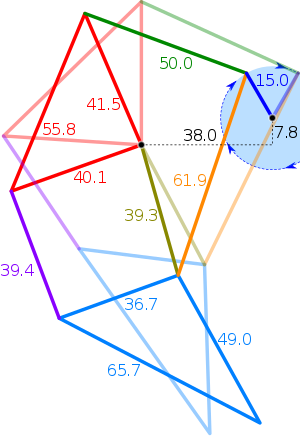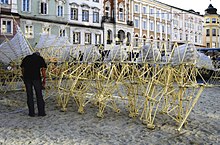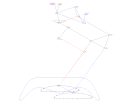simple design
a modified ratio of linkage and building of a wooden model (mainly for orientation about size)
basic trivia from WIKI: Theo Jansen (1948) is a Dutch artist. In 1990, he began building large mechanisms out of yellow plastic tubes (PVC) that are able to move on their own, known only as Strandbeest. The kinetic sculptures appear to walk. His animated works are intended to be a fusion of art and engineering, and he has said that "The walls between art and engineering exist only in our minds." He strives to equip his creations with their own artificial intelligence so they can avoid obstacles such as the sea by changing course when one is detected.
main page: http://www.strandbeest.com/
http://www.strandbeest.com/beests_leg.php
__________________________________
blog with a collection of content related to Jansen linkage (similar to this post here) - creator of this blog Joe Klan has also invented his own linkage which animate movement similar to spider. So blog is: mechanical spider
- links on examples
- multi-legged walking machine
- design of planar leg mechanism
- -
- design of Jansen's linkage
- The Design and Optimization of a Crank-Based Leg Mechanism by Amanda Ghassaei
a modified ratio of linkage and building of a wooden model (mainly for orientation about size)
basic trivia from WIKI: Theo Jansen (1948) is a Dutch artist. In 1990, he began building large mechanisms out of yellow plastic tubes (PVC) that are able to move on their own, known only as Strandbeest. The kinetic sculptures appear to walk. His animated works are intended to be a fusion of art and engineering, and he has said that "The walls between art and engineering exist only in our minds." He strives to equip his creations with their own artificial intelligence so they can avoid obstacles such as the sea by changing course when one is detected.
main page: http://www.strandbeest.com/
http://www.strandbeest.com/beests_leg.php
__________________________________
blog with a collection of content related to Jansen linkage (similar to this post here) - creator of this blog Joe Klan has also invented his own linkage which animate movement similar to spider. So blog is: mechanical spider
Jansen's linkage
From Wikipedia, the free encyclopedia
The Jansen's linkage is a leg mechanism designed by the kinetic sculptor Theo Jansen to simulate a smooth walking motion[1] Jansen has used his mechanism in a variety of kinetic sculptures which are known as Strandbeests. Jansen's linkage bears artistic as well as mechanical merit for its simulation of organic walking motion using a simple rotary input.[2] Jansen's linkage is a robotic platform based on Theo Jansen's natural gearing mechanism. This work is focused in the design and development of the low cost robotic platform. The components used are readily available and inexpensive which makes it easy to build
From Wikipedia, the free encyclopedia
The Jansen's linkage is a leg mechanism designed by the kinetic sculptor Theo Jansen to simulate a smooth walking motion[1] Jansen has used his mechanism in a variety of kinetic sculptures which are known as Strandbeests. Jansen's linkage bears artistic as well as mechanical merit for its simulation of organic walking motion using a simple rotary input.[2] Jansen's linkage is a robotic platform based on Theo Jansen's natural gearing mechanism. This work is focused in the design and development of the low cost robotic platform. The components used are readily available and inexpensive which makes it easy to build
Illustrations[edit]
Leg mechanism
From Wikipedia, the free encyclopedia
A leg mechanism (walking mechanism) is an assembly of links and joints (a linkage) intended to simulate the walking motion of humans or animals. Mechanical legs can have one or more actuators, and can perform simple planar or complex motion.
Compared to a wheel, a leg mechanism is potentially better fitted to uneven terrain, as it can step over obstacles.[1]
Contents
[hide]Design goals[edit]
- vertical speed as constant as possible while touching the ground (support phase)[1][2]
- while the foot is not touching the ground, it should move as fast as possible
- constant torque/force input (or at least no extreme spikes/changes)
- stride height (enough for clearance, not too much to conserve energy)
- the foot has to touch the ground for at least half of the cycle for a two/four leg mechanism[1] or respectively, a third of the cycle for a three/six leg mechanism
- minimized moving mass
- vertical center of mass always inside the base of support[1]
- the speed of each leg or group of legs should be separately controllable for steering[2]
- the leg mechanism should allow forward and backward walking[2]
Another design goal can be, that stride height and length etc. can be controlled by the operator.[2] This can relatively easily be achieved with a hydraulic leg mechanism, but is not practicable with a crank-based leg mechanism.[2]
The optimization has to be done for the whole vehicle – ideally the force/torque variation during a rotation should cancel each other out.[1]
History[edit]
Richard Lovell Edgeworth tried in 1770 to construct a machine he called a "Wooden Horse", but was not successful.[3][4]
The Plantigrade Machine by Pafnuty Chebyshev was shown at the Exposition Universelle (1878).
Gallery[edit]
Stationary[edit]
Walking[edit]
| * | 4 legs | 6 legs |
|---|---|---|
| Strandbeest |  |  |
| Ghassaei |  |  |
| Klann linkage 1 |  |  |
| Klann linkage 2 |  | |
| Plantigrade Mechanism |  |
Complex mechanism[edit]
Shown above are only planar mechanisms, but there are also more complex mechanism:
- links on examples
links on diagrams:
- beauty: An openly designed Creative Commons licensed robot- multi-legged walking machine
- design of planar leg mechanism
- -
- design of Jansen's linkage
- The Design and Optimization of a Crank-Based Leg Mechanism by Amanda Ghassaei
- Analysis Of Theo Jansen Mechanism (Strandbeest) And Its Comparative Advantages Over Wheel Based Mine Escavation System by Swadhin Patnaik
more literature:
- A proposal of the extended mechanism for Theo Jansen linkage to modify the walking
elliptic orbit and a study of cyclic base function
- Theo Jansen's Mechanism based pitch marking robot
- A study of availability and extensibility of Theo Jansen mechanism toward climbing over bumps
- Dynamic Modeling and Nonlinear Position Control of a Quadruped Robot with Theo Jansen inkage Mechanisms and a Single Actuator
- Dynamic Modeling and Nonlinear Position Control of a Quadruped Robot with Theo Jansen Linkage Mechanisms and a Single Actuator
- Analysis and synthesis of the walking linkage of Theo Jansenwith a flywheel
elliptic orbit and a study of cyclic base function
- Theo Jansen's Mechanism based pitch marking robot
- A study of availability and extensibility of Theo Jansen mechanism toward climbing over bumps
- Dynamic Modeling and Nonlinear Position Control of a Quadruped Robot with Theo Jansen inkage Mechanisms and a Single Actuator
- Dynamic Modeling and Nonlinear Position Control of a Quadruped Robot with Theo Jansen Linkage Mechanisms and a Single Actuator
- Analysis and synthesis of the walking linkage of Theo Jansenwith a flywheel
















Nice!
ReplyDelete